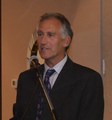Achieving the Cascading Objectives for Inter-Regional Collaboration would create a Watershed Health Legacy in the Georgia Basin

“Accepted ‘standards of practice’ – especially those for engineering, planning and finance – influence the form and function of the Built Environment. Implementing green infrastructure, turning the clock back, shifting the ecological baseline, and creating a watershed legacy will ultimately depend on the nature of changes in standards of practice,” states Kim Stephens.










